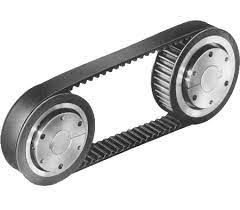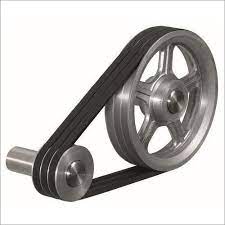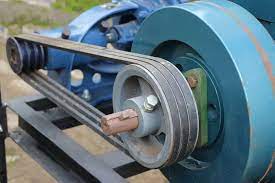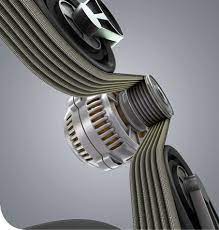Product Description
1. The pulley can be divided into driving pulley (head pulley) and thurnabout pulley (tail pulley), driving pulley is the main part for transmitting the power : smooth surface and rubber surface, and rubber surface can be classified into smooth rubber surface, herringbone rubber surface and CHINAMFG rubber surface to meet different technical requirements. Averting pulley can be classified into smooth rubber surface and smooth steel surface.
According to the structure style, the 2 type pulley can be divided into 3 light duty, medium duty and heavy duty.
All the pulley adopt integrated bearing housing which is lubricated and filled with grease and has 2 kinds: iron casting and steel casting, the shaft is made of 45#steel, the shell adopt weld assembly.
Based on the above design, the pulley is reasonably structured, convenient type selected, performance reliable, long life time.
Our pulleys are of stable structure, good performance and long operating life. They can work normally in dusty, wet and muddy environment.
2. Outer diameter deviation of Drive pulley(mm)
| Pulley diameter | ≤400 | >400~1000 | >1000 |
| The Maximum Deviation | 0~1.50 | 0~2.0 | 0~2.5 |
3. Radial Runout of roller excircle(mm)
| Pulley diameter | ≤800 | >800~1600 | >1600 |
| Cover pulley | 0.6 | 1.0 | 1.5 |
| Non- cover pulley | 1.1 | 1.5 | 2.0 |
4. Range of Production
Diameters of pulley (mm): 200/250/315/320/400/500/630/800/1000/1200/1250
Length of pulley depends on the width of conveyor belt.
The width Range of conveyor belt (mm): 500/650/800/1000/1200/1400
Applications: Used in the steel industry, harbor, coal industry, power industry, cements industry, and more.
| Description | CEMA, DIN, JIS, AS, SABS, ISO Standard Design & JXIHU (WEST LAKE) DIS. ODM |
| Pipe | 1) Material : Q235 carbon steel equal to DIN S235JR 2) Roller Diameter : φ50mm ~ φ219mm / 2 inch ~ 8 5/8 inch 3) Roller Length: 150mm ~ 3000 mm 4) Thickness : 3.0 ~6.0 mm |
| Shaft | 1) Material : 45# steel equal to DIN C45 2) Cold-drawn bright round steel 3) Shaft Diameter: 20mm, 25mm, 30mm, 40mm, 45mm, 50mm |
| Bearing | 1) Single Row Deep Groove Ball Bearing 2RS&ZZ with C3 clearance 2) Brand: SKF,FAG,NSK,HRB, LYC, CHINAMFG or according to your requirement |
| Bearing Housing | 1) Material : Q235 carbon steel equal to DIN S235JR 2) Cold press working fit ISO M7 accuracy 3) Material thickness: 2.5mm ~ 5.0mm |
| Seals | 1) Labyrinth seal, nylon 6 material 2) JXIHU (WEST LAKE) DIS.’s patented product |
| Grease | 2# Lithium grease lubricant |
| Painting | 1) Ordinary painting, hot galvanized painting, Powder painting 2) Color: Black, red, yellow, blue or according to your requirement |
| Structure: | Conveyor System |
|---|---|
| Material: | Carbon Steel |
| Application: | Chemical Industry, Grain Transport, Mining Transport, Power Plant |
| Condition: | New |
| Transport Package: | Wooden Cases |
| Specification: | diameter from 50mm to 219mm |
| Samples: |
US$ 0/Piece
1 Piece(Min.Order) | |
|---|
| Customization: |
Available
| Customized Request |
|---|

What safety considerations should be kept in mind when working with drive belt pulleys?
Working with drive belt pulleys requires careful attention to safety to prevent accidents and injuries. Here are some important safety considerations to keep in mind when working with drive belt pulleys:
1. Power Isolation:
Before working on any part of the power transmission system, such as the drive belt or pulleys, ensure that the power source is completely shut off. This may involve disconnecting the battery or disabling the engine. This precaution prevents accidental engagement of moving parts and reduces the risk of injury.
2. Protective Gear:
Wear appropriate personal protective equipment (PPE) when working with drive belt pulleys. This typically includes safety glasses or goggles to protect the eyes from debris or loose particles. Additionally, gloves may be necessary to provide hand protection from sharp edges or pinch points.
3. Vehicle Stability:
If working on a vehicle, ensure the vehicle is parked on a flat and stable surface. Engage the parking brake and use wheel chocks to prevent unintended movement. This stability reduces the risk of the vehicle shifting during the repair process.
4. Cooling Period:
Allow the engine and other components to cool down before working on the drive belt pulleys. Hot components can cause burns or other injuries. Take caution and avoid touching hot surfaces to prevent burns.
5. Proper Tools and Equipment:
Use the appropriate tools and equipment for the task at hand. This may include wrenches, sockets, pulley removal tools, or tensioning tools. Using the correct tools ensures proper handling and reduces the risk of damaging the pulleys or other components.
6. Correct Belt Routing:
When replacing or adjusting drive belts, ensure the new belt is routed correctly according to the manufacturer’s specifications. Improper belt routing can lead to decreased performance, premature wear, or even belt failure, causing potential safety hazards.
7. Belt Tension:
When adjusting belt tension, follow the manufacturer’s recommendations. Over-tensioning or under-tensioning the belt can lead to poor performance, excessive wear, or belt slippage. Improper tensioning can also strain the pulleys, affecting their lifespan and potentially causing damage.
8. Proper Alignment:
Ensure the drive belt pulleys are properly aligned during installation. Misaligned pulleys can cause belt tracking issues, increased wear, and noise. Use alignment tools or follow the manufacturer’s guidelines to achieve properalignment.
9. Avoid Loose Clothing and Jewelry:
When working with drive belt pulleys, avoid wearing loose clothing, jewelry, or accessories that can get caught in the moving parts. Loose clothing or dangling jewelry can pose a significant safety risk if they become entangled in the pulleys or other rotating components.
10. Follow Manufacturer Guidelines:
Always refer to the vehicle manufacturer’s guidelines, service manual, or specific instructions provided by the pulley manufacturer. These guidelines often include important safety information and specific procedures for working with drive belt pulleys.
11. Seek Professional Help if Unsure:
If you are unsure about any aspect of working with drive belt pulleys or encounter complex issues, it is advisable to seek professional assistance from qualified mechanics or automotive technicians. They have the experience, knowledge, and specialized tools to handle the repairs safely and efficiently.
By keeping these safety considerations in mind, you can minimize the risks associated with working with drive belt pulleys and ensure a safe working environment for yourself and others involved in the repair process.

How are drive belt pulleys used in the production of consumer appliances?
Drive belt pulleys play a crucial role in the production of consumer appliances. Here’s a detailed explanation of how drive belt pulleys are utilized in the manufacturing of consumer appliances:
1. Motor-to-Mechanism Power Transmission:
Consumer appliances, such as washing machines, dryers, dishwashers, and refrigerators, often require the transfer of power from an electric motor to various mechanisms within the appliance. Drive belt pulleys are used to connect the motor shaft to other components, such as pumps, agitators, drum assemblies, or fans. By using pulleys, the rotational power from the motor can be efficiently transmitted to the desired mechanism, allowing the appliance to perform its intended function.
2. Speed Control and Gear Reduction:
In certain consumer appliances, it is necessary to control the speed of rotating components or achieve gear reduction. Drive belt pulleys, in conjunction with different pulley sizes or gear ratios, enable speed control and gear reduction. By adjusting the pulley sizes or using multiple pulleys, the rotational speed of the driven components can be modified to match the desired operational requirements. This ensures the efficient and optimal performance of the consumer appliances.
3. Belt-Driven Mechanisms:
Consumer appliances often utilize belt-driven mechanisms for tasks such as agitating, spinning, mixing, or pumping. Drive belt pulleys are an integral part of these mechanisms, providing the necessary power transmission and tensioning for the belts. The pulleys ensure that the belts remain properly tensioned, allowing for reliable and efficient operation of the belt-driven mechanisms in the appliances.
4. Tensioning and Belt Adjustment:
Drive belt pulleys are used in consumer appliances to facilitate belt tensioning and adjustment. Tensioned belts ensure proper power transmission and prevent slippage. Pulleys with adjustable positions or tensioning mechanisms allow for easy and accurate belt tensioning, ensuring optimal performance and preventing premature belt wear or damage. The ability to adjust belt tension is particularly important in appliances with components that may experience variable loads or require periodic maintenance.
5. Noise and Vibration Control:
Drive belt pulleys contribute to noise and vibration control in consumer appliances. Well-designed pulleys with proper alignment and balanced operation help minimize vibrations and reduce noise generated during appliance operation. This enhances the overall user experience by providing quieter and smoother appliance functionality.
6. System Integration and Customization:
Drive belt pulleys offer flexibility in the production of consumer appliances by enabling system integration and customization. Manufacturers can utilize different pulley sizes, configurations, and arrangements to design appliances that meet specific performance and operational requirements. The adaptability of drive belt pulleys allows for the incorporation of different motor types, speeds, and driven components, ensuring the appliances are tailored to meet consumer needs.
7. Maintenance and Serviceability:
In consumer appliances, drive belt pulleys can contribute to ease of maintenance and serviceability. Pulleys that are designed for easy accessibility, with removable covers or guards, simplify maintenance procedures. This allows for efficient belt replacement, tension adjustment, or component servicing, minimizing downtime and enhancing the longevity of the appliances.
8. Energy Efficiency:
Efficient power transmission is crucial for achieving energy efficiency in consumer appliances. Drive belt pulleys help optimize power transfer from the motor to the driven components, minimizing energy losses. By using properly sized and designed pulleys, appliance manufacturers can enhance the energy efficiency of their products, resulting in reduced energy consumption and lower operating costs for consumers.
In summary, drive belt pulleys are extensively used in the production of consumer appliances for motor-to-mechanism power transmission, speed control, belt-driven mechanisms, tensioning, noise and vibration control, system integration, maintenance and serviceability, and energy efficiency. Their presence ensures reliable and efficient operation of the appliances, ultimately enhancing user satisfaction and product performance.

How do drive belt pulleys assist in power transmission within vehicles?
Drive belt pulleys play a crucial role in power transmission within vehicles, ensuring the efficient operation of various components. Here’s a detailed explanation of how drive belt pulleys assist in power transmission within vehicles:
1. Power Source Connection:
The drive belt pulley is connected to the power source, typically the engine crankshaft in vehicles. It is mounted on a shaft that rotates with the engine. As the engine runs, the rotational motion of the crankshaft is transferred to the drive belt pulley.
2. Belt Engagement:
A belt, such as a V-belt or a serpentine belt, is routed around the drive belt pulley and other driven components. The belt is specifically designed to fit into the grooves of the pulley’s rim. When the drive belt pulley rotates, it engages with the belt, causing the belt to move along with the pulley.
3. Power Transfer:
As the drive belt pulley rotates and drives the belt, the rotational power from the engine is transmitted to the belt. The belt, in turn, transfers this power to other components connected to it. These components can include the alternator, water pump, power steering pump, air conditioning compressor, and other accessories.
4. Multiple Component Operation:
Drive belt pulleys are designed to accommodate multiple belts and drive various components simultaneously. In vehicles, a single drive belt pulley can be responsible for driving several components at once. This allows for the efficient operation of multiple systems and accessories within the vehicle.
5. Speed Variation and Torque Transfer:
The use of different-sized drive belt pulleys can vary the speed ratio between the engine and the driven components. By altering the diameter of the pulleys, the rotational speed and torque can be adjusted. This allows for optimized power delivery to different components, matching their specific requirements.
6. Tension Adjustment:
Drive belt pulleys often incorporate tensioning mechanisms to ensure proper belt tension. Proper tensioning is crucial for optimal power transmission and to prevent belt slippage. Tensioning mechanisms, such as spring-loaded arms or adjustable brackets, enable easy maintenance and adjustment of belt tension.
7. Noise and Vibration Damping:
Drive belt pulleys help dampen noise and vibrations generated by the engine and other components. The flexibility and elasticity of the belt, along with the design of the pulley, act as a cushion, reducing the transmission of vibrations and providing smoother operation.
8. Efficient Power Distribution:
Drive belt pulleys ensure the efficient distribution of power within the vehicle. By transferring power from the engine to various components, they enable the functioning of critical systems such as electrical generation, cooling, steering assistance, and air conditioning. This ensures the vehicle’s proper operation and enhances the driving experience.
Overall, drive belt pulleys are integral components in vehicle power transmission systems. By connecting the power source to driven components, accommodating multiple belts, enabling speed variation and torque transfer, and maintaining proper belt tension, they facilitate the efficient operation of various systems and accessories within vehicles.


editor by CX
2023-10-09























